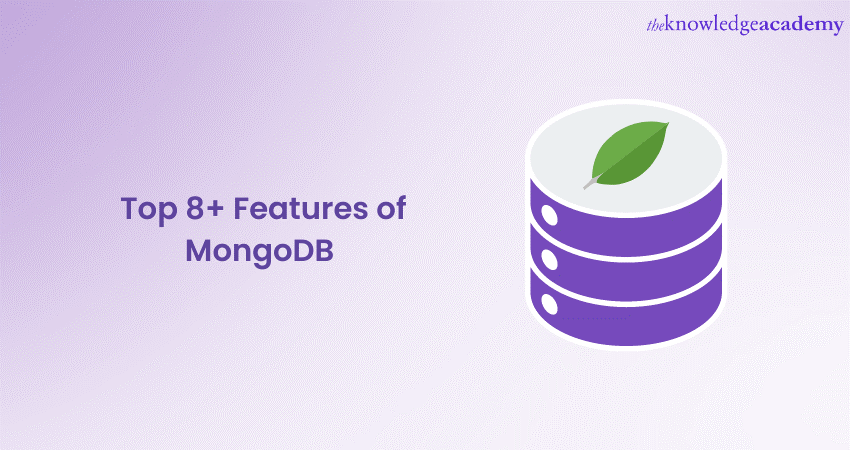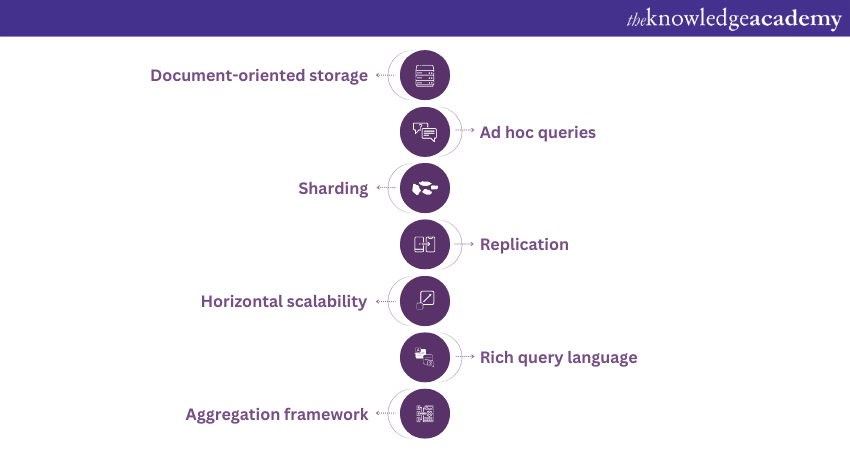We may not have the course you’re looking for. If you enquire or give us a call on +971 8000311193 and speak to our training experts, we may still be able to help with your training requirements.
Training Outcomes Within Your Budget!
We ensure quality, budget-alignment, and timely delivery by our expert instructors.

MongoDB, a groundbreaking creation of MongoDB Inc. in 2007, brings an array of innovative features to the database management landscape. These MongoDB Features are designed to meet the evolving needs of modern application development, transforming the traditional table-based relational database structure and championing a NoSQL approach instead. The ability to manage diverse data formats sets this language apart from its predecessors in database technologies.
According to Statista, MongoDB ranked second as the most popular database skill, with 17.89 per cent of developers stating they wish to use this language. Its unique document data model ensures seamless storage of virtually any data type without compromising on powerful indexing capabilities. Therefore, key features of MongoDB present an impressive solution for businesses and developers grappling with complex and evolving data. Keep reading this blog to learn about the top MongoDB Features. These features do not just make MongoDB a popular database but a benchmark in database technology.
Table of Contents
1) An introduction to MongoDB
2) What are some MongoDB Features?
a) Document-oriented storage
b) Ad hoc queries
c) Sharding
d) High availability with replication
e) Auto-sharding for horizontal scalability
f) Rich query language
g) Aggregation framework
3) Conclusion
An introduction to MongoDB
MongoDB is a cross-platform, document-oriented database program created by MongoDB Inc. Birthed from the rising need for more scalable, agile solutions, MongoDB was a response to traditional relational databases that often couldn't keep pace with the rapid development of modern applications.
It is a NoSQL database, meaning it abandons the traditional table-based relational database structure and uses JSON-like documents with optional schemas, providing greater flexibility and scalability. MongoDB's unique approach of using a document data model enables storage of any data type without compromising powerful indexing options, data access, or validation rules.
Its superiority over previous technologies lies in its ability to manage large unstructured data, efficient scaling capabilities, and versatility in handling various data formats. Thus, MongoDB stands as an innovative and compelling solution for businesses and developers dealing with complex, changeable data.
Learn about various technologies with our App & Web Development Training!
What are some MongoDB Features?
When determining the features of MongoDB, one considers key aspects such as its inherent flexibility in handling diverse data types and structures. It can include scalability to grow with your data needs, performance in processing large data volumes swiftly and reliability for consistent data availability. Some other features may include ease of use for developers and its versatility in managing various data scenarios. These MongoDB key features set the foundation for its popularity. Let's explore some such features.

Document-oriented storage
MongoDB revolutionises data management by using a document-oriented storage system, a stark departure from SQL databases' traditional table-based structure. Instead, MongoDB employs BSON (Binary JSON) documents. These BSON documents accommodate richer data types while still supporting traditional JSON-style notation. This flexible storage model simplifies the process of storing data with diverse structures, especially when dealing with hierarchical relationships, array-based data, and other complex formats prevalent in today's applications.
Ad hoc queries
One of MongoDB's standout features is the support for ad hoc queries, a fundamental aspect of its versatility. This functionality supports real-time data retrieval, allowing searches based on specific fields, ranges, and even regular expression queries. More than that, you can search within secondary indexes, with the freedom to include queries over arrays and nested objects. As a result, you can refine, filter, and manipulate your data in myriad ways, offering a truly flexible and powerful data analytics platform.
Learn the fundamentals of MongoDB with our MongoDB Developer Course Today!
Sharding
MongoDB has a robust solution through a feature called sharding, which aids it in managing vast amounts of data. Sharding is a method of splitting and distributing data across numerous servers. This process allows MongoDB to manage extensive data volumes and sustain high traffic loads, overcoming the limitations of single-server deployments. Dispersing the database load with sharding provides horizontal scaling - a feature that often eludes traditional relational databases, giving MongoDB an edge in handling big data.
Here's a simplified demonstration of how you might enable sharding for a database and a collection:
|
mongo --host localhost --port 27017 use admin db.runCommand( { enableSharding: "myDatabase" } ) db.runCommand( { shardCollection: "myDatabase.myCollection", key: { "fieldName" : 1 } } ) |
High availability with replication
MongoDB ensures that your data is always available and safeguarded against potential losses using a built-in replication feature. It works by creating 'replica sets' - groups of MongoDB servers that maintain the same data set. If a primary server fails, an automated election process identifies a new primary from the remaining secondaries in the set. This feature means that your system can recover swiftly from hardware failures and service interruptions, providing added reliability for your database.
Learn to build beautiful websites with our Elm Web Development Training!
Auto-sharding for horizontal scalability
For systems dealing with ever-growing data, MongoDB provides Auto-Sharding. Auto-sharding is an automatic scaling process where data is distributed across multiple servers. As the data volume inflates, MongoDB automatically expands its resources to prevent any performance degradation. Adding more machines to share the load allows MongoDB to ensure consistent, robust performance regardless of data growth.
Rich query language
MongoDB provides a comprehensive query language with a wide range of features, including CRUD operations (Create, Read, Update, Delete), indexing, and more. Its richness stems from the variety of ways you can access data, from simple retrieval to complex aggregations and transformations. Furthermore, because MongoDB's query language uses a syntax similar to JSON, it is easy to learn and use, especially for those already familiar with JSON structures.
Aggregation framework
With MongoDB's powerful aggregation framework, you can perform sophisticated data analysis right within the database. The framework offers a pipeline mechanism, allowing you to string together multiple operation stages to process and return your data in a single query. Stages include matching (to filter documents), grouping (to collate data), sorting (to arrange data), and various other transformation operations. This feature facilitates complex data transformations and analytics, expanding the boundaries of what you can achieve with your data.
Conclusion
To wrap up, the range of MongoDB Features we've explored clearly demonstrates its standing as a formidable NoSQL database solution. From managing complex data types to ensuring high scalability and availability, MongoDB's unique feature set enables it to effortlessly meet the needs of contemporary application development. It's evident that MongoDB is making waves in the era of big data.
Learn the basics of web development with our Introduction to HTML Course!
Frequently Asked Questions
Upcoming Data, Analytics & AI Resources Batches & Dates
Date
 MongoDB Certification Course
MongoDB Certification Course
Fri 22nd Nov 2024
Fri 21st Feb 2025
Fri 25th Apr 2025
Fri 20th Jun 2025
Fri 22nd Aug 2025
Fri 17th Oct 2025
Fri 19th Dec 2025







 Top Rated Course
Top Rated Course



 If you wish to make any changes to your course, please
If you wish to make any changes to your course, please


